Genetic Testing for Familial Hyperlipidemia: Barriers and Solutions
VerifiedAdded on 2020/05/16
|9
|1860
|114
Report
AI Summary
This report delves into the complexities of genetic testing for familial hyperlipidemia (FH), a condition characterized by elevated LDL-C levels. It examines controversies surrounding routine genetic screenings, cost considerations, and the potential benefits of testing, particularly for individuals with borderline LDL levels or those lacking family pedigrees. The report applies the Knowledge to Action (KTA) framework to explore implementation strategies, including knowledge transfer interventions like risk communication, counseling, and educational outreach campaigns, targeting healthcare providers, patients, and insurance companies. It identifies key individuals involved, such as patients, primary care facilities, and insurance companies, and discusses barriers to implementation, including lack of knowledge, negative attitudes, and insurance limitations. Strategies to overcome these barriers are proposed, emphasizing education, awareness campaigns, and translational research to increase the predictive value of genetic tests and facilitate their integration into healthcare practice.
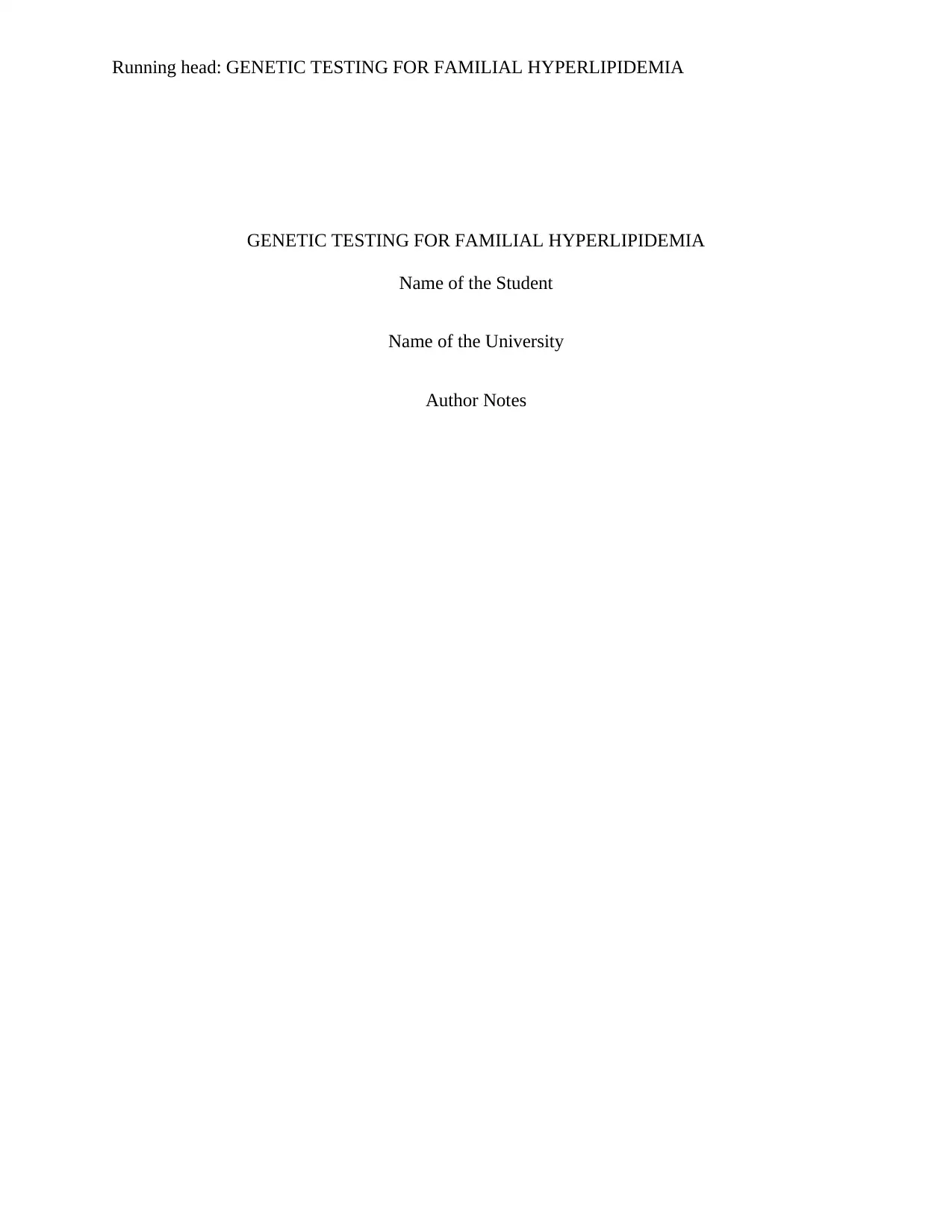
Running head: GENETIC TESTING FOR FAMILIAL HYPERLIPIDEMIA
GENETIC TESTING FOR FAMILIAL HYPERLIPIDEMIA
Name of the Student
Name of the University
Author Notes
GENETIC TESTING FOR FAMILIAL HYPERLIPIDEMIA
Name of the Student
Name of the University
Author Notes
Paraphrase This Document
Need a fresh take? Get an instant paraphrase of this document with our AI Paraphraser
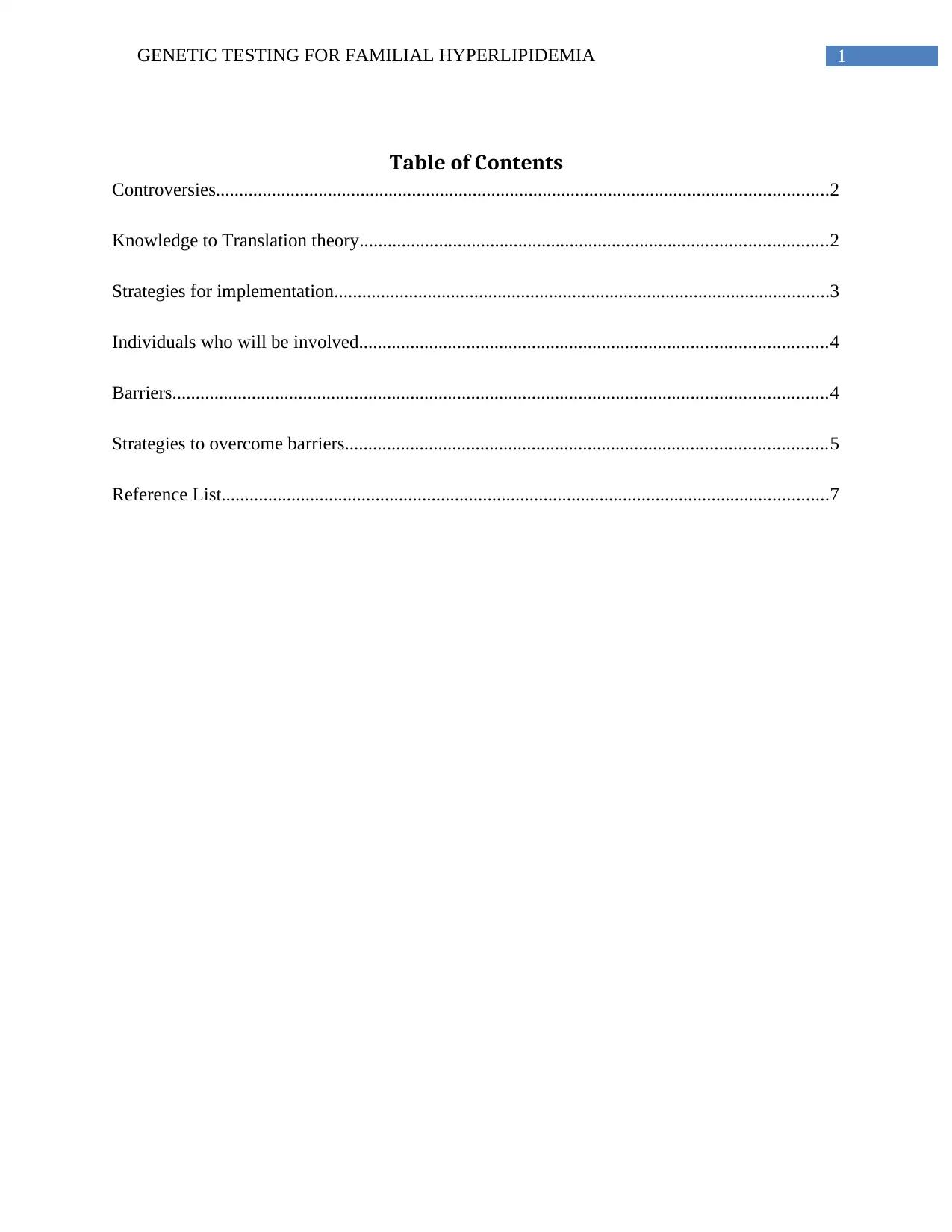
1GENETIC TESTING FOR FAMILIAL HYPERLIPIDEMIA
Table of Contents
Controversies...................................................................................................................................2
Knowledge to Translation theory....................................................................................................2
Strategies for implementation..........................................................................................................3
Individuals who will be involved....................................................................................................4
Barriers............................................................................................................................................4
Strategies to overcome barriers.......................................................................................................5
Reference List..................................................................................................................................7
Table of Contents
Controversies...................................................................................................................................2
Knowledge to Translation theory....................................................................................................2
Strategies for implementation..........................................................................................................3
Individuals who will be involved....................................................................................................4
Barriers............................................................................................................................................4
Strategies to overcome barriers.......................................................................................................5
Reference List..................................................................................................................................7

2GENETIC TESTING FOR FAMILIAL HYPERLIPIDEMIA
Controversies
Familial Hypercholesterolemia/Hyperlipidemia or FH is characterized by elevated levels
of low density lipoprotein cholesterol or LDL-C and is caused as a result of the autosomal
dominant disorder associated with lipoprotein metabolism. The most important cause of genetic
coronary heart disease is the heterozygous form of FH. Genetic testing is done in order to
provide definite diagnosis of individuals with high levels of LDL-C. Such genetic testing helps
to identify mutations in the genes such as LDLR, APOB, PCSK9, among others (Bruikman,
Hovingh & Kastelein, 2017).
Some of the controversies associated with genetic testing for detection of high cholesterol
levels is that routine screenings of lipid levels by genetic testing are not done and according to
the doctors they are able to diagnose the medical condition without the use of such genetic tests.
Moreover, the costs associated with genetic testing although is reasonable but such costs are too
high with respect to diagnosis of FH. However, physicians do believe that genetic testing would
be useful in order to screen families having borderline levels of LDL or an adopted person can
determine the FH status due to lack of access to family pedigree. However, genetic testing can be
used to detect the presence of mutations that are associated with FH in children below 18 years
of age since normal screening procedures will not be useful as these children do not show the
presence of coronary heart diseases. Moreover, with the decline in the costs of the genetic tests,
the issue associated with affordability does not apply no more (Ncbi.nlm.nih.gov, 2018).
Controversies
Familial Hypercholesterolemia/Hyperlipidemia or FH is characterized by elevated levels
of low density lipoprotein cholesterol or LDL-C and is caused as a result of the autosomal
dominant disorder associated with lipoprotein metabolism. The most important cause of genetic
coronary heart disease is the heterozygous form of FH. Genetic testing is done in order to
provide definite diagnosis of individuals with high levels of LDL-C. Such genetic testing helps
to identify mutations in the genes such as LDLR, APOB, PCSK9, among others (Bruikman,
Hovingh & Kastelein, 2017).
Some of the controversies associated with genetic testing for detection of high cholesterol
levels is that routine screenings of lipid levels by genetic testing are not done and according to
the doctors they are able to diagnose the medical condition without the use of such genetic tests.
Moreover, the costs associated with genetic testing although is reasonable but such costs are too
high with respect to diagnosis of FH. However, physicians do believe that genetic testing would
be useful in order to screen families having borderline levels of LDL or an adopted person can
determine the FH status due to lack of access to family pedigree. However, genetic testing can be
used to detect the presence of mutations that are associated with FH in children below 18 years
of age since normal screening procedures will not be useful as these children do not show the
presence of coronary heart diseases. Moreover, with the decline in the costs of the genetic tests,
the issue associated with affordability does not apply no more (Ncbi.nlm.nih.gov, 2018).
⊘ This is a preview!⊘
Do you want full access?
Subscribe today to unlock all pages.

Trusted by 1+ million students worldwide
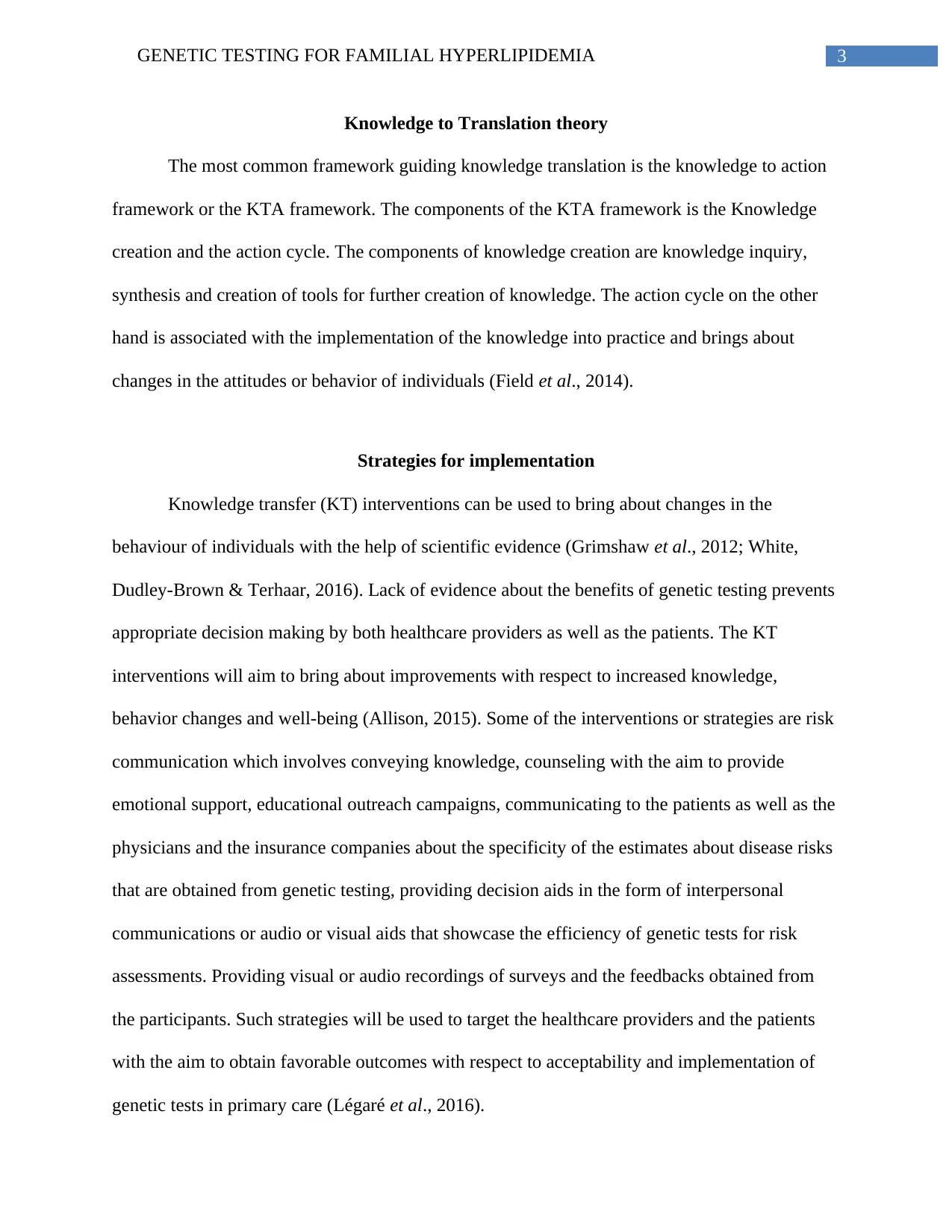
3GENETIC TESTING FOR FAMILIAL HYPERLIPIDEMIA
Knowledge to Translation theory
The most common framework guiding knowledge translation is the knowledge to action
framework or the KTA framework. The components of the KTA framework is the Knowledge
creation and the action cycle. The components of knowledge creation are knowledge inquiry,
synthesis and creation of tools for further creation of knowledge. The action cycle on the other
hand is associated with the implementation of the knowledge into practice and brings about
changes in the attitudes or behavior of individuals (Field et al., 2014).
Strategies for implementation
Knowledge transfer (KT) interventions can be used to bring about changes in the
behaviour of individuals with the help of scientific evidence (Grimshaw et al., 2012; White,
Dudley-Brown & Terhaar, 2016). Lack of evidence about the benefits of genetic testing prevents
appropriate decision making by both healthcare providers as well as the patients. The KT
interventions will aim to bring about improvements with respect to increased knowledge,
behavior changes and well-being (Allison, 2015). Some of the interventions or strategies are risk
communication which involves conveying knowledge, counseling with the aim to provide
emotional support, educational outreach campaigns, communicating to the patients as well as the
physicians and the insurance companies about the specificity of the estimates about disease risks
that are obtained from genetic testing, providing decision aids in the form of interpersonal
communications or audio or visual aids that showcase the efficiency of genetic tests for risk
assessments. Providing visual or audio recordings of surveys and the feedbacks obtained from
the participants. Such strategies will be used to target the healthcare providers and the patients
with the aim to obtain favorable outcomes with respect to acceptability and implementation of
genetic tests in primary care (Légaré et al., 2016).
Knowledge to Translation theory
The most common framework guiding knowledge translation is the knowledge to action
framework or the KTA framework. The components of the KTA framework is the Knowledge
creation and the action cycle. The components of knowledge creation are knowledge inquiry,
synthesis and creation of tools for further creation of knowledge. The action cycle on the other
hand is associated with the implementation of the knowledge into practice and brings about
changes in the attitudes or behavior of individuals (Field et al., 2014).
Strategies for implementation
Knowledge transfer (KT) interventions can be used to bring about changes in the
behaviour of individuals with the help of scientific evidence (Grimshaw et al., 2012; White,
Dudley-Brown & Terhaar, 2016). Lack of evidence about the benefits of genetic testing prevents
appropriate decision making by both healthcare providers as well as the patients. The KT
interventions will aim to bring about improvements with respect to increased knowledge,
behavior changes and well-being (Allison, 2015). Some of the interventions or strategies are risk
communication which involves conveying knowledge, counseling with the aim to provide
emotional support, educational outreach campaigns, communicating to the patients as well as the
physicians and the insurance companies about the specificity of the estimates about disease risks
that are obtained from genetic testing, providing decision aids in the form of interpersonal
communications or audio or visual aids that showcase the efficiency of genetic tests for risk
assessments. Providing visual or audio recordings of surveys and the feedbacks obtained from
the participants. Such strategies will be used to target the healthcare providers and the patients
with the aim to obtain favorable outcomes with respect to acceptability and implementation of
genetic tests in primary care (Légaré et al., 2016).
Paraphrase This Document
Need a fresh take? Get an instant paraphrase of this document with our AI Paraphraser
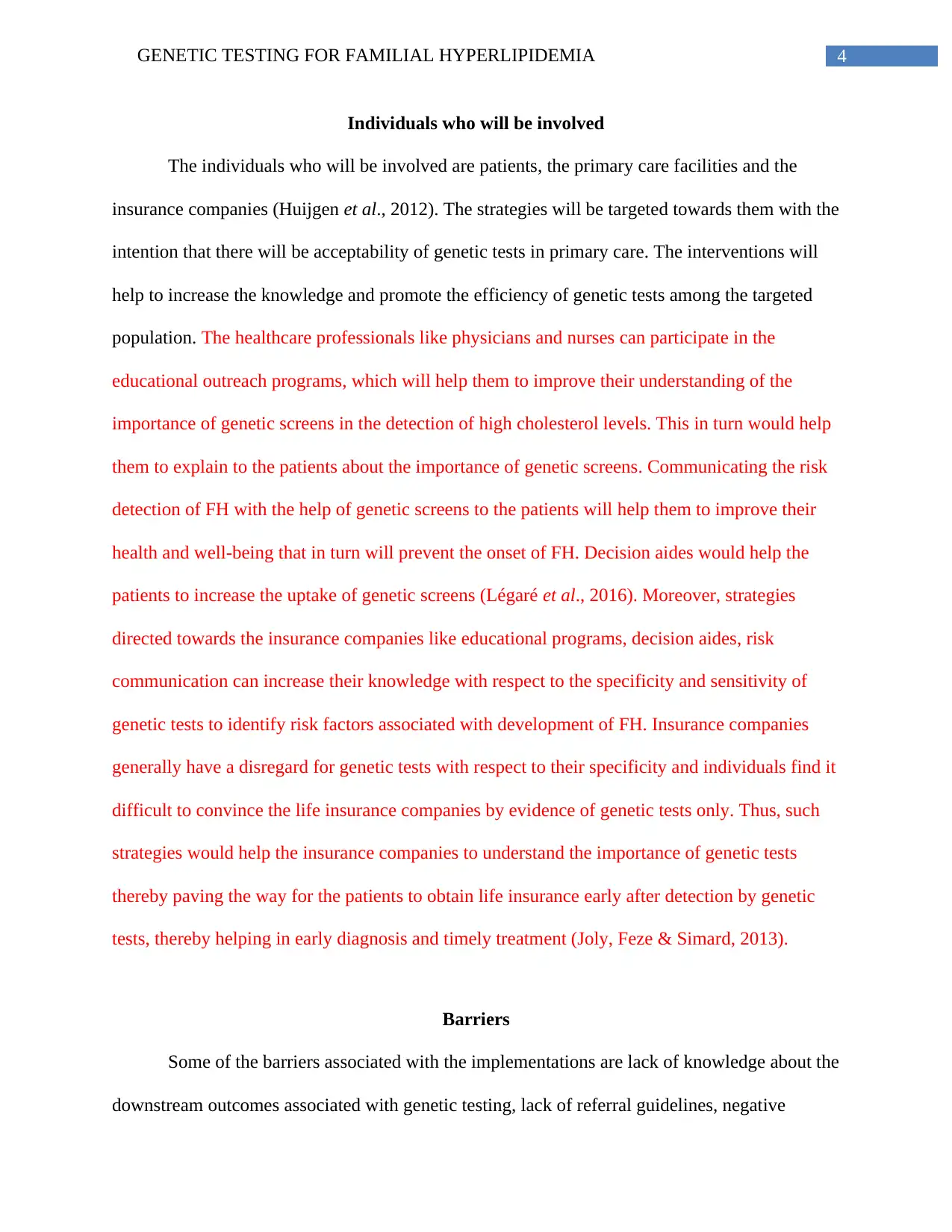
4GENETIC TESTING FOR FAMILIAL HYPERLIPIDEMIA
Individuals who will be involved
The individuals who will be involved are patients, the primary care facilities and the
insurance companies (Huijgen et al., 2012). The strategies will be targeted towards them with the
intention that there will be acceptability of genetic tests in primary care. The interventions will
help to increase the knowledge and promote the efficiency of genetic tests among the targeted
population. The healthcare professionals like physicians and nurses can participate in the
educational outreach programs, which will help them to improve their understanding of the
importance of genetic screens in the detection of high cholesterol levels. This in turn would help
them to explain to the patients about the importance of genetic screens. Communicating the risk
detection of FH with the help of genetic screens to the patients will help them to improve their
health and well-being that in turn will prevent the onset of FH. Decision aides would help the
patients to increase the uptake of genetic screens (Légaré et al., 2016). Moreover, strategies
directed towards the insurance companies like educational programs, decision aides, risk
communication can increase their knowledge with respect to the specificity and sensitivity of
genetic tests to identify risk factors associated with development of FH. Insurance companies
generally have a disregard for genetic tests with respect to their specificity and individuals find it
difficult to convince the life insurance companies by evidence of genetic tests only. Thus, such
strategies would help the insurance companies to understand the importance of genetic tests
thereby paving the way for the patients to obtain life insurance early after detection by genetic
tests, thereby helping in early diagnosis and timely treatment (Joly, Feze & Simard, 2013).
Barriers
Some of the barriers associated with the implementations are lack of knowledge about the
downstream outcomes associated with genetic testing, lack of referral guidelines, negative
Individuals who will be involved
The individuals who will be involved are patients, the primary care facilities and the
insurance companies (Huijgen et al., 2012). The strategies will be targeted towards them with the
intention that there will be acceptability of genetic tests in primary care. The interventions will
help to increase the knowledge and promote the efficiency of genetic tests among the targeted
population. The healthcare professionals like physicians and nurses can participate in the
educational outreach programs, which will help them to improve their understanding of the
importance of genetic screens in the detection of high cholesterol levels. This in turn would help
them to explain to the patients about the importance of genetic screens. Communicating the risk
detection of FH with the help of genetic screens to the patients will help them to improve their
health and well-being that in turn will prevent the onset of FH. Decision aides would help the
patients to increase the uptake of genetic screens (Légaré et al., 2016). Moreover, strategies
directed towards the insurance companies like educational programs, decision aides, risk
communication can increase their knowledge with respect to the specificity and sensitivity of
genetic tests to identify risk factors associated with development of FH. Insurance companies
generally have a disregard for genetic tests with respect to their specificity and individuals find it
difficult to convince the life insurance companies by evidence of genetic tests only. Thus, such
strategies would help the insurance companies to understand the importance of genetic tests
thereby paving the way for the patients to obtain life insurance early after detection by genetic
tests, thereby helping in early diagnosis and timely treatment (Joly, Feze & Simard, 2013).
Barriers
Some of the barriers associated with the implementations are lack of knowledge about the
downstream outcomes associated with genetic testing, lack of referral guidelines, negative
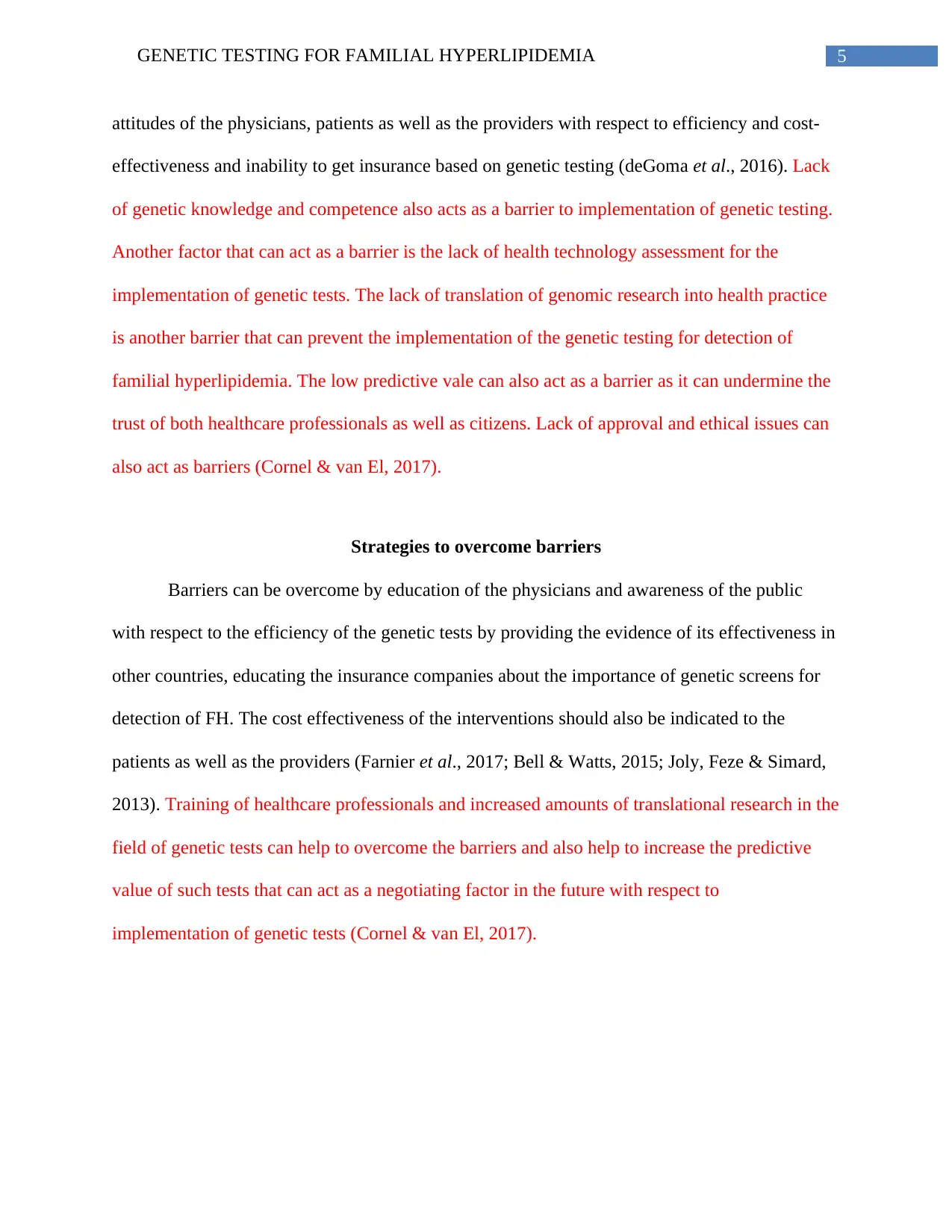
5GENETIC TESTING FOR FAMILIAL HYPERLIPIDEMIA
attitudes of the physicians, patients as well as the providers with respect to efficiency and cost-
effectiveness and inability to get insurance based on genetic testing (deGoma et al., 2016). Lack
of genetic knowledge and competence also acts as a barrier to implementation of genetic testing.
Another factor that can act as a barrier is the lack of health technology assessment for the
implementation of genetic tests. The lack of translation of genomic research into health practice
is another barrier that can prevent the implementation of the genetic testing for detection of
familial hyperlipidemia. The low predictive vale can also act as a barrier as it can undermine the
trust of both healthcare professionals as well as citizens. Lack of approval and ethical issues can
also act as barriers (Cornel & van El, 2017).
Strategies to overcome barriers
Barriers can be overcome by education of the physicians and awareness of the public
with respect to the efficiency of the genetic tests by providing the evidence of its effectiveness in
other countries, educating the insurance companies about the importance of genetic screens for
detection of FH. The cost effectiveness of the interventions should also be indicated to the
patients as well as the providers (Farnier et al., 2017; Bell & Watts, 2015; Joly, Feze & Simard,
2013). Training of healthcare professionals and increased amounts of translational research in the
field of genetic tests can help to overcome the barriers and also help to increase the predictive
value of such tests that can act as a negotiating factor in the future with respect to
implementation of genetic tests (Cornel & van El, 2017).
attitudes of the physicians, patients as well as the providers with respect to efficiency and cost-
effectiveness and inability to get insurance based on genetic testing (deGoma et al., 2016). Lack
of genetic knowledge and competence also acts as a barrier to implementation of genetic testing.
Another factor that can act as a barrier is the lack of health technology assessment for the
implementation of genetic tests. The lack of translation of genomic research into health practice
is another barrier that can prevent the implementation of the genetic testing for detection of
familial hyperlipidemia. The low predictive vale can also act as a barrier as it can undermine the
trust of both healthcare professionals as well as citizens. Lack of approval and ethical issues can
also act as barriers (Cornel & van El, 2017).
Strategies to overcome barriers
Barriers can be overcome by education of the physicians and awareness of the public
with respect to the efficiency of the genetic tests by providing the evidence of its effectiveness in
other countries, educating the insurance companies about the importance of genetic screens for
detection of FH. The cost effectiveness of the interventions should also be indicated to the
patients as well as the providers (Farnier et al., 2017; Bell & Watts, 2015; Joly, Feze & Simard,
2013). Training of healthcare professionals and increased amounts of translational research in the
field of genetic tests can help to overcome the barriers and also help to increase the predictive
value of such tests that can act as a negotiating factor in the future with respect to
implementation of genetic tests (Cornel & van El, 2017).
⊘ This is a preview!⊘
Do you want full access?
Subscribe today to unlock all pages.

Trusted by 1+ million students worldwide

6GENETIC TESTING FOR FAMILIAL HYPERLIPIDEMIA
Paraphrase This Document
Need a fresh take? Get an instant paraphrase of this document with our AI Paraphraser
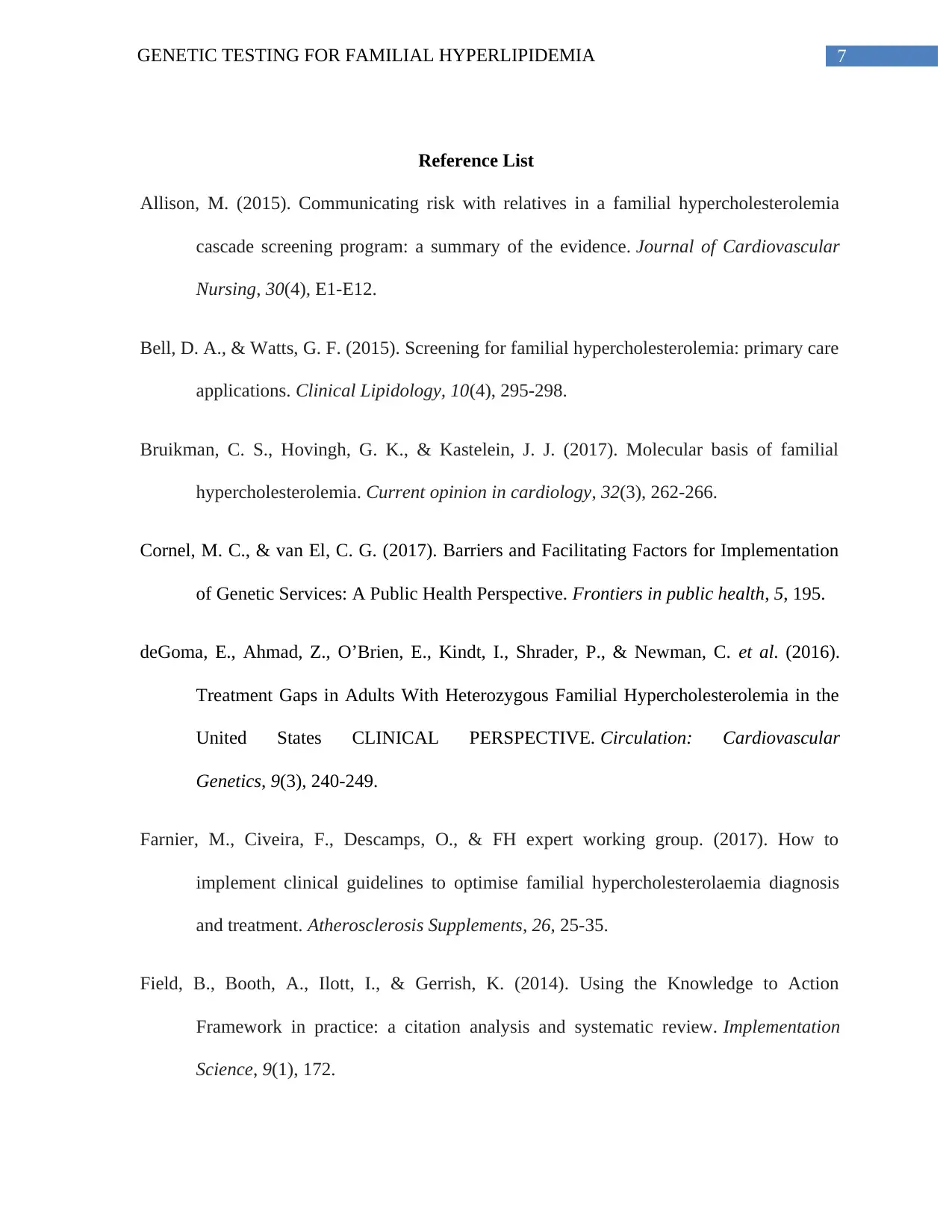
7GENETIC TESTING FOR FAMILIAL HYPERLIPIDEMIA
Reference List
Allison, M. (2015). Communicating risk with relatives in a familial hypercholesterolemia
cascade screening program: a summary of the evidence. Journal of Cardiovascular
Nursing, 30(4), E1-E12.
Bell, D. A., & Watts, G. F. (2015). Screening for familial hypercholesterolemia: primary care
applications. Clinical Lipidology, 10(4), 295-298.
Bruikman, C. S., Hovingh, G. K., & Kastelein, J. J. (2017). Molecular basis of familial
hypercholesterolemia. Current opinion in cardiology, 32(3), 262-266.
Cornel, M. C., & van El, C. G. (2017). Barriers and Facilitating Factors for Implementation
of Genetic Services: A Public Health Perspective. Frontiers in public health, 5, 195.
deGoma, E., Ahmad, Z., O’Brien, E., Kindt, I., Shrader, P., & Newman, C. et al. (2016).
Treatment Gaps in Adults With Heterozygous Familial Hypercholesterolemia in the
United States CLINICAL PERSPECTIVE. Circulation: Cardiovascular
Genetics, 9(3), 240-249.
Farnier, M., Civeira, F., Descamps, O., & FH expert working group. (2017). How to
implement clinical guidelines to optimise familial hypercholesterolaemia diagnosis
and treatment. Atherosclerosis Supplements, 26, 25-35.
Field, B., Booth, A., Ilott, I., & Gerrish, K. (2014). Using the Knowledge to Action
Framework in practice: a citation analysis and systematic review. Implementation
Science, 9(1), 172.
Reference List
Allison, M. (2015). Communicating risk with relatives in a familial hypercholesterolemia
cascade screening program: a summary of the evidence. Journal of Cardiovascular
Nursing, 30(4), E1-E12.
Bell, D. A., & Watts, G. F. (2015). Screening for familial hypercholesterolemia: primary care
applications. Clinical Lipidology, 10(4), 295-298.
Bruikman, C. S., Hovingh, G. K., & Kastelein, J. J. (2017). Molecular basis of familial
hypercholesterolemia. Current opinion in cardiology, 32(3), 262-266.
Cornel, M. C., & van El, C. G. (2017). Barriers and Facilitating Factors for Implementation
of Genetic Services: A Public Health Perspective. Frontiers in public health, 5, 195.
deGoma, E., Ahmad, Z., O’Brien, E., Kindt, I., Shrader, P., & Newman, C. et al. (2016).
Treatment Gaps in Adults With Heterozygous Familial Hypercholesterolemia in the
United States CLINICAL PERSPECTIVE. Circulation: Cardiovascular
Genetics, 9(3), 240-249.
Farnier, M., Civeira, F., Descamps, O., & FH expert working group. (2017). How to
implement clinical guidelines to optimise familial hypercholesterolaemia diagnosis
and treatment. Atherosclerosis Supplements, 26, 25-35.
Field, B., Booth, A., Ilott, I., & Gerrish, K. (2014). Using the Knowledge to Action
Framework in practice: a citation analysis and systematic review. Implementation
Science, 9(1), 172.
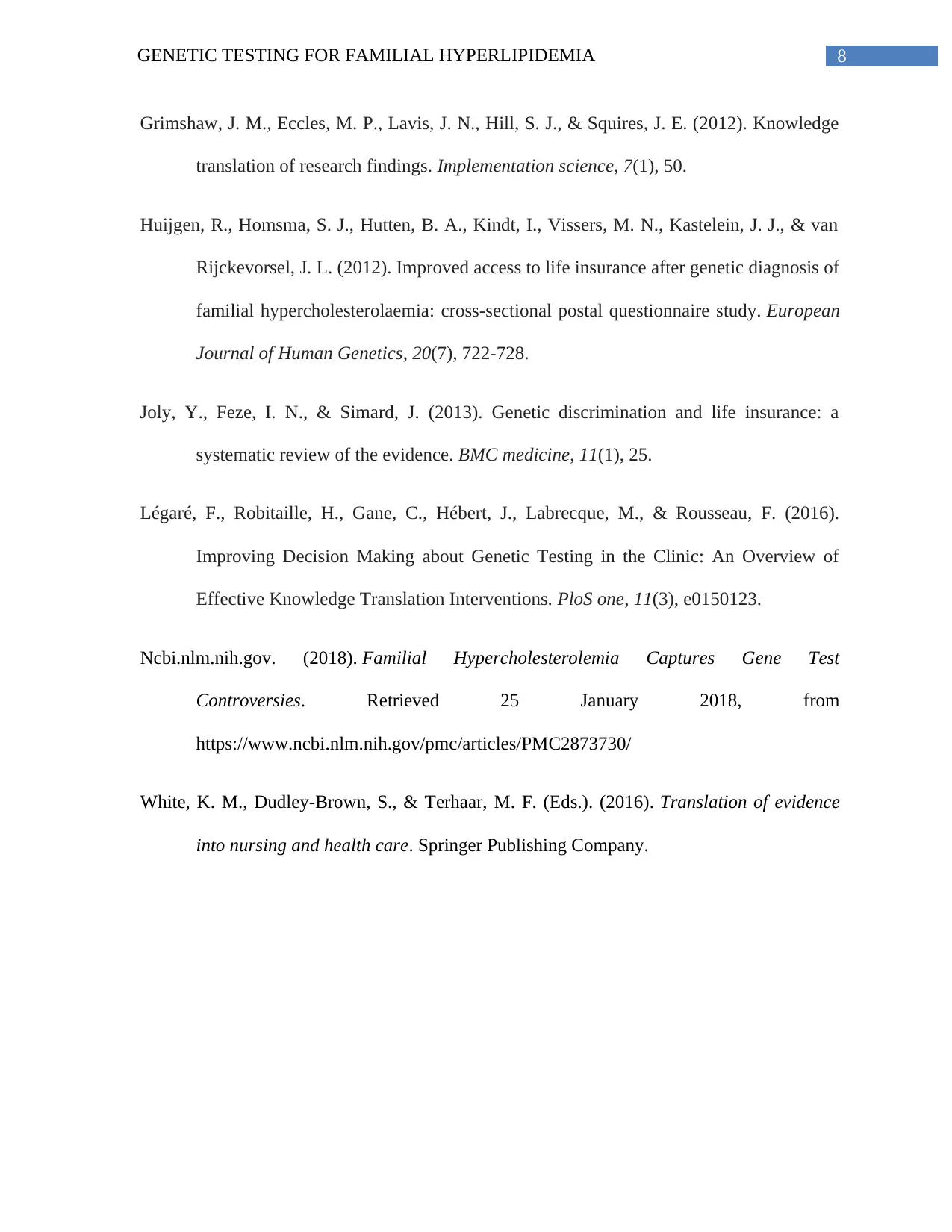
8GENETIC TESTING FOR FAMILIAL HYPERLIPIDEMIA
Grimshaw, J. M., Eccles, M. P., Lavis, J. N., Hill, S. J., & Squires, J. E. (2012). Knowledge
translation of research findings. Implementation science, 7(1), 50.
Huijgen, R., Homsma, S. J., Hutten, B. A., Kindt, I., Vissers, M. N., Kastelein, J. J., & van
Rijckevorsel, J. L. (2012). Improved access to life insurance after genetic diagnosis of
familial hypercholesterolaemia: cross-sectional postal questionnaire study. European
Journal of Human Genetics, 20(7), 722-728.
Joly, Y., Feze, I. N., & Simard, J. (2013). Genetic discrimination and life insurance: a
systematic review of the evidence. BMC medicine, 11(1), 25.
Légaré, F., Robitaille, H., Gane, C., Hébert, J., Labrecque, M., & Rousseau, F. (2016).
Improving Decision Making about Genetic Testing in the Clinic: An Overview of
Effective Knowledge Translation Interventions. PloS one, 11(3), e0150123.
Ncbi.nlm.nih.gov. (2018). Familial Hypercholesterolemia Captures Gene Test
Controversies. Retrieved 25 January 2018, from
https://www.ncbi.nlm.nih.gov/pmc/articles/PMC2873730/
White, K. M., Dudley-Brown, S., & Terhaar, M. F. (Eds.). (2016). Translation of evidence
into nursing and health care. Springer Publishing Company.
Grimshaw, J. M., Eccles, M. P., Lavis, J. N., Hill, S. J., & Squires, J. E. (2012). Knowledge
translation of research findings. Implementation science, 7(1), 50.
Huijgen, R., Homsma, S. J., Hutten, B. A., Kindt, I., Vissers, M. N., Kastelein, J. J., & van
Rijckevorsel, J. L. (2012). Improved access to life insurance after genetic diagnosis of
familial hypercholesterolaemia: cross-sectional postal questionnaire study. European
Journal of Human Genetics, 20(7), 722-728.
Joly, Y., Feze, I. N., & Simard, J. (2013). Genetic discrimination and life insurance: a
systematic review of the evidence. BMC medicine, 11(1), 25.
Légaré, F., Robitaille, H., Gane, C., Hébert, J., Labrecque, M., & Rousseau, F. (2016).
Improving Decision Making about Genetic Testing in the Clinic: An Overview of
Effective Knowledge Translation Interventions. PloS one, 11(3), e0150123.
Ncbi.nlm.nih.gov. (2018). Familial Hypercholesterolemia Captures Gene Test
Controversies. Retrieved 25 January 2018, from
https://www.ncbi.nlm.nih.gov/pmc/articles/PMC2873730/
White, K. M., Dudley-Brown, S., & Terhaar, M. F. (Eds.). (2016). Translation of evidence
into nursing and health care. Springer Publishing Company.
⊘ This is a preview!⊘
Do you want full access?
Subscribe today to unlock all pages.

Trusted by 1+ million students worldwide
1 out of 9
Your All-in-One AI-Powered Toolkit for Academic Success.
+13062052269
info@desklib.com
Available 24*7 on WhatsApp / Email
![[object Object]](/_next/static/media/star-bottom.7253800d.svg)
Unlock your academic potential
Copyright © 2020–2025 A2Z Services. All Rights Reserved. Developed and managed by ZUCOL.